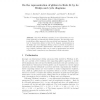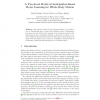120
click to vote
ACRI
2008
Springer
15 years 6 months ago
2008
Springer
Abstract. Rule 54, in Wolfram’s notation, is one of elementary yet complexly behaving one-dimensional cellular automata. The automaton supports gliders, glider guns and other non...
114
click to vote
ACRI
2008
Springer
15 years 6 months ago
2008
Springer
This article studies the convergence properties of some 2D cellular automata, when a single cell is updated at random at each time step. We tackle this question for a particular s...
152
click to vote
ABIALS
2008
Springer
15 years 6 months ago
2008
Springer
Abstract— Starting from the situated and embodied perspective on the study of biological cognition as a source of inspiration, this paper programmatically outlines a path towards...
157
click to vote
ABIALS
2008
Springer
15 years 6 months ago
2008
Springer
Simulation theories have in recent years proposed that a cognitive agent's "inner world" can at least partly be constituted by internal emulations or simulations of ...
142
Voted
ABIALS
2008
Springer
15 years 6 months ago
2008
Springer
Abstract. We present a model of motor learning based on a combination of Operational Space Control and Optimal Control. Anticipatory processes are used both in the learning of the ...
147
click to vote
ABIALS
2008
Springer
15 years 6 months ago
2008
Springer
Abstract. Human action is goal-directed and must thus be guided by anticipations of wanted action effects. How anticipatory action control is possible and how it can emerge from ex...
118
Voted
ABIALS
2008
Springer
15 years 6 months ago
2008
Springer
Grasping an object successfully implies avoiding colliding into it before the hand is closed around the object. The present study focuses on prehension kinematics that typically re...
111
click to vote
ABIALS
2008
Springer
15 years 6 months ago
2008
Springer
Anticipation and prediction have been identified as key functions of many brain areas facilitating recognition, perception, and planning. In this chapter we present a hierarchical ...
107
Voted
TPHOL
2008
IEEE
15 years 6 months ago
2008
IEEE
Although graphs are very common in computer science, they are still very difficult to handle for proof assistants as proving properties of graphs may require heavy computations. T...
92
Voted
TPHOL
2008
IEEE
15 years 6 months ago
2008
IEEE
In this paper, we present an approach to describe uniformly iterated “big” operations, like Pn i=0 f(i) or maxi∈I f(i) and to provide lemmas that encapsulate all the commonly...


